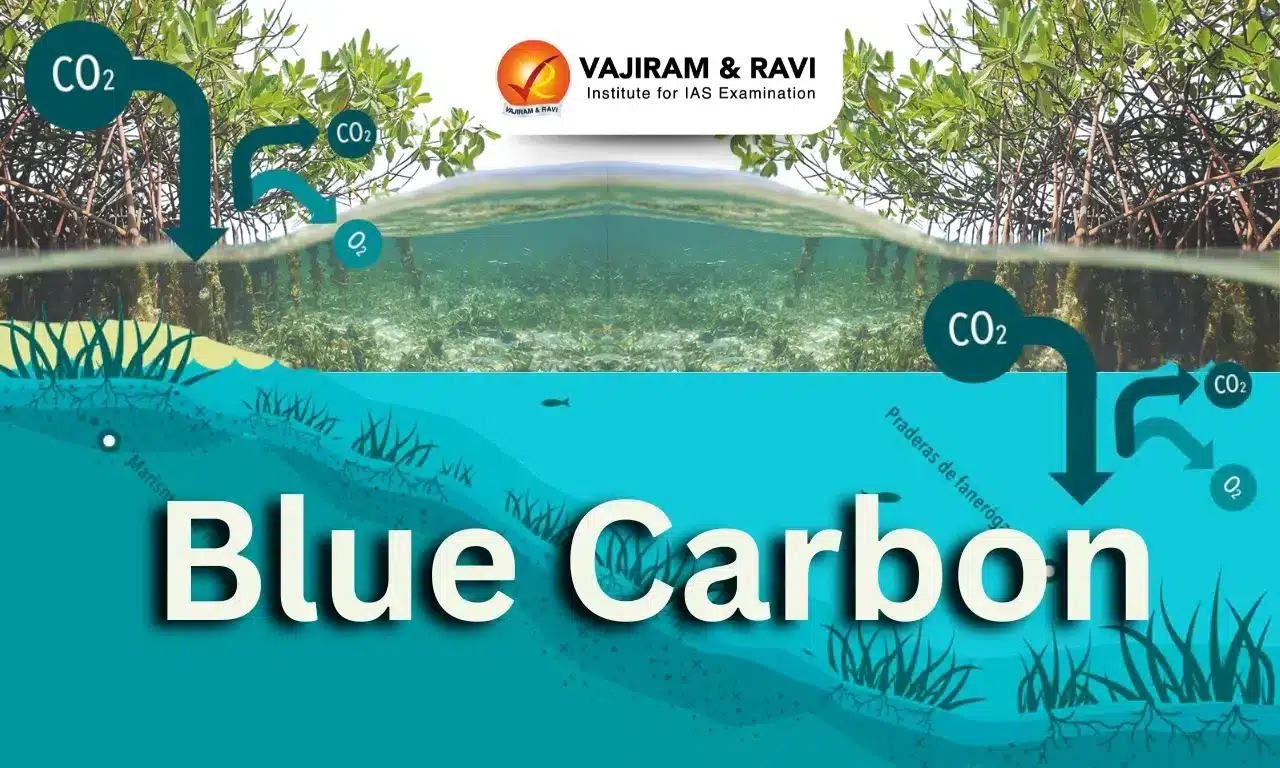Blue Carbon Latest News
Recent studies suggest that mangroves and coastal wetlands annually sequester carbon at a rate 10 times greater than mature tropical forests.
About Blue Carbon
- Blue Carbon is the carbon captured by the world’s ocean and coastal ecosystems.
- The world’s mangroves, sea grasses and salt marshes together comprise ‘blue carbon ecosystems.’ They are nature’s most effective carbon sinks.
- Coastal ecosystems such as mangroves, tidal marshes and seagrass meadows sequester and store more carbon per unit area than terrestrial forests and are now being recognised for their role in mitigating climate change.
- Activities are causing loss of coastal blue carbon ecosystems
- The main causes of conversion and degradation of blue carbon ecosystems vary around the world but are largely driven by human activities.
- Common drivers are aquaculture, agriculture, mangrove forest exploitation, terrestrial and marine sources of pollution and industrial and urban coastal development.
Significance of Blue Carbon Ecosystems
- They have the potential to help people and coastal environments mitigate and adapt to climate change.
- They help sustain the environment by mitigating climate change.
- These ecosystems also provide essential benefits for climate change adaptation, including coastal protection and food security for many coastal communities.
Blue Carbon FAQs
Q1: What is blue carbon vs green carbon?
Ans: Blue carbon is the carbon stored and sequestered by coastal and marine ecosystems, such as mangroves, seagrasses and salt marshes. Green carbon is the carbon stored by terrestrial ecosystems, including forests and other land-based vegetation.
Q2: What is purple carbon?
Ans: Carbon captured through the air or industrial emissions.
Q3: What is brown carbon UPSC?
Ans: It is released by the combustion of organic matter
Q4: What is green carbon?
Ans: Green carbon is the carbon stored in the plants and soil of natural ecosystems
Q5:What are the benefits of blue carbon?
Ans: It benefits wildlife, water quality, storm surge protection, and local economies.
Source: DTE
Last updated on June, 2025
→ UPSC Notification 2025 was released on 22nd January 2025.
→ UPSC Prelims Result 2025 is out now for the CSE held on 25 May 2025.
→ UPSC Prelims Question Paper 2025 and Unofficial Prelims Answer Key 2025 are available now.
→ UPSC Calendar 2026 is released on 15th May, 2025.
→ The UPSC Vacancy 2025 were released 1129, out of which 979 were for UPSC CSE and remaining 150 are for UPSC IFoS.
→ UPSC Mains 2025 will be conducted on 22nd August 2025.
→ UPSC Prelims 2026 will be conducted on 24th May, 2026 & UPSC Mains 2026 will be conducted on 21st August 2026.
→ The UPSC Selection Process is of 3 stages-Prelims, Mains and Interview.
→ UPSC Result 2024 is released with latest UPSC Marksheet 2024. Check Now!
→ UPSC Toppers List 2024 is released now. Shakti Dubey is UPSC AIR 1 2024 Topper.
→ Also check Best IAS Coaching in Delhi






















